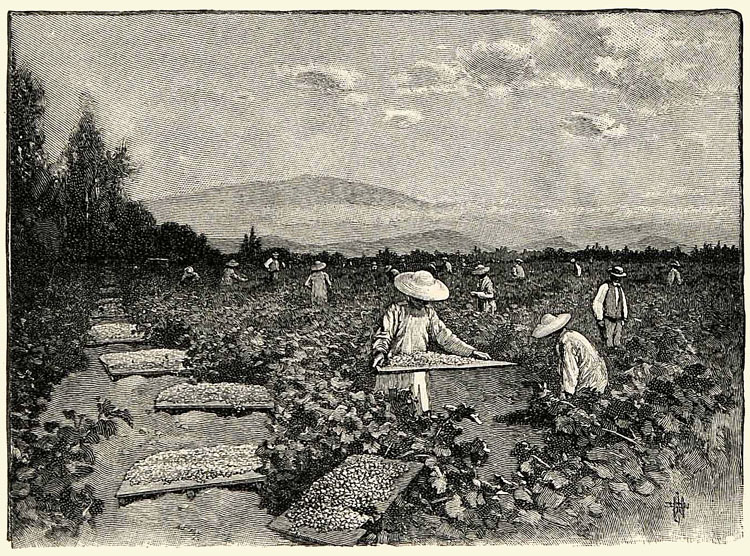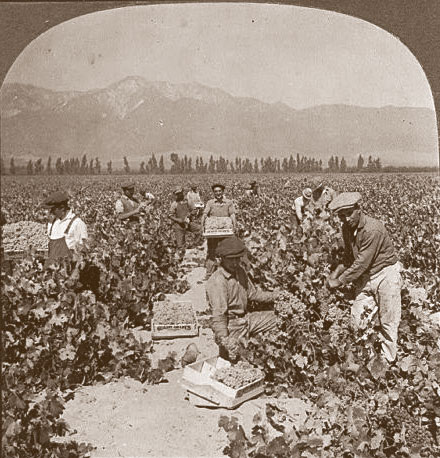METHOD of Curing GRAPES for Raisins
Edward Antill
Transactions of the American Philosophical Society
2nd Edition, 1789, pp262-266
|
|
JARR RAISINS or Raisins of the Sun cured in the most perfect manner, so as to retain their full flavor, and keep long without candying,
is done in the following manner:
Build a hurdle or stage two feet from the ground, or two feet high, and so long as to hold all the bunches you intend to
cure at a time, so as to lie single without touching each other, the bed of the stage is made of split reeds, of willows,
or any other shrub, that will lie level and smooth, and for want of such it may be made of long rye straw, the ends of which
only has been threshed. Then thatch two sides a little longer than the stage, with smooth straw, so close as easily
to turn off a shower of rain, and yet so light as to be fixed up upon the stage, and to be taken down at pleasure, the ground under
the stage must be covered with straw to keep the damps from rising, and to reflect heat.
This being done prepare a lixivium of ashes, that is, a lye, about half as
strong as that you make soap of which bears an egg; this you put into
a broad shallow iron kettle, the quantity according to the number of
grapes you intend to cure. Set it a boiling, and throw into it a handful or two of clean salt to four gallons of lye, and one pint
of sweet oil, or a pound and a half of good sweet butter; then having tied three or four bunches of the fairest and full ripe grapes
together, taking away the rotten, and all the unripe ones, and stirring first the oil or butter
very well into the lye, the lye now boiling, you put as many bunches in as will near cover the surface, and let them scald pretty well, but not too much
so as to be boiled; take them out gently into a wide flat cullender, without bruising, and lay them gently upon the stage, unbind
them and lay every bunch single by itself, so as not to touch each other; if your stage be large so that you scald a great many
bunches to fill it, and before you have done, or near done, you have reason to believe that your oil or butter is expended, you throw in as much more as you
think will finish your quantity, for this adds richness to the raisins, and preserves them long without candying.

If
you have hands to hold the bunches by the strings wilst they scald, it would be best, because they would be handled without bruising, and indeed
this is the design of tying so many bunches together, but if you are alone, or have but one hand with you, and cannot well hold bunches enough to cover the surface of
the kettle, the best way would be to cast the bunches in single and to take them out with a slice or a skimmer.
When your stage is full, about three hours after you have done, turn the bunches into a dry place on the stage, so that no wet may touch them,
and that they may dry as soon as possible; before sun set, at least half an hour, set up your roof and cover them from dews and rain; the next morning
as soon as the dews and damps are exhaled, uncover them, and turn them tiwce that day, and so on till they are pretty moderately dry,
so as to be fit for keeping; then put them into jars with covers and plaster them over with clay and horse dung, and set them away in a
dry cool place till you use or dispose of them; but beware of damps;
And observe that you are to begin this work in the wain of the moon, your grapes must be fully ripe and taken from the vines when quite dry.
All fruits gathered in the wain of the moon will keep longer sound and good, than those gathered in the increase.
Note also that
these raisins thus cured, are fit for princes, for the rich and great, and ought to fetch a good price, since no raisins can be more delicious.
The common raisins must be scalded the same way, and about the same time, and may be spread upon hurdles, laid on straw on the ground, and hauled in
under some shed or covering, at night, before sun set, and brought out in the morning, and when dried put into small casks, such as raisins come in.
The Malaga grape is esteemed the finest for raisins, but as the northern colonies, I mean the bread colonies, will not as yet produce them,
they being too tender and too late ripe, we may however be supplied among ourselves from the red Frontiniac, which is a very rich sweet grape,
is early ripe and makes very good raisins.

Malaga Grapes
|
|





